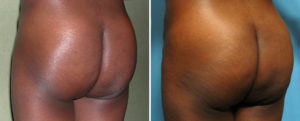The Brazilian Butt Lift is one of the most popular and talked about body contouring procedures in the past few years. Driven by celebrities, models and the desire for a certain look in clothes, a rounder and fuller buttock shape has taken on a new level of aesthetic desire and sensuality. While it is often viewed as having a heavy cultural and ethnic influence amongst African-Americans and Hispanics in the U.S., its awareness has also served to drive in women who simply have a congenitally flat buttocks with no roundness as well.
The main driving force in the desire for bigger buttocks comes from the most common procedure to achieve it…the Brazilian Butt Lift. (aka BBL) Using fat to enlarge the buttocks is both a natural approach and a method of recycling or redistribution. Using liposuction to harvest fat from undesired body places, it is then processed and injected where someone wants it in the buttocks. In essence, every BBL is two procedures in one both of which work to create an improved torso shape. The appeal of this dual approach has led to making it a sought after aesthetic procedure.
But despite the tremendous appeal of the BBL buttock augmentation procedure and its widespread use, much of the science behind it remains undeveloped. The success of the BBL is in making the injected fat survive. But how to best do that is unknown and the techniques touted are based on largely subjective observations. There are no published studies as of yet that have looked at the various methods of buttock fat injection or have even compared them.

Since it is commonly believed that only about one-third to one-half of injected fat will survive, the maximal infusion approach takes a volume overload concept to overcoming low fat cell survival. Of course every patient wants the most fat put into their buttocks as possible and this can be seen in many internet forums where patient talk and compare about how much fat was injected into their buttocks. The disadvantage to this approach is that big globs of injected fat may preclude the rapid establishment of vascular ingrowth and nutrition to the fat/stem cells. So while good volume results may be initially seen, lack of significant fat survival will lead to poor results months later.
The seeding approach is when smaller amounts of fat are injected, much of it into the muscle, and it takes time to see these ‘seeds’ grow. Like planting seeds into a garden the analogy is that multiple seeding sessions are needed to acquire the best growth. Smaller amounts of seeding theoretically makes it more likely that nourishment will be established to the fat cells quickly and survival will be much better, even if the actual volume is lower. How much volume that is will depend on the patient’s buttock size but a 300cc to 500cc injection volume per side is reasonable.

While the fat grafting science of buttock augmentation is slowly being developed, the marketing of the BBL procedure is way out in front it. Fundamentally the Brazilian Butt Lift is neither Brazilian nor does it cause a buttock lift. It causes no more of a buttock lift than does a breast implant cause a breast lift. It is a volume enhancer. But more is not always better and one should beware of BBL procedures that tout high volume infusions. Besides fat survival issues, high volume may mean fat transfers that contain other components such as tumescent fluid, fat and free lipids. While early after surgery photos may show a big volume buttock change, much if not all may be lost months later.
Dr. Barry Eppley
Indianapolis, Indiana


